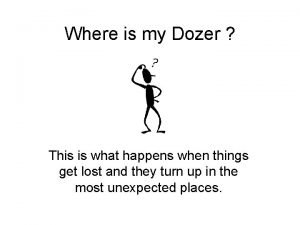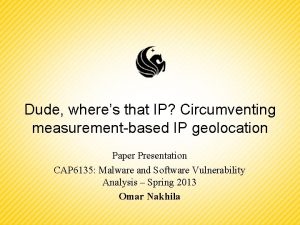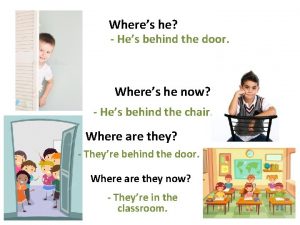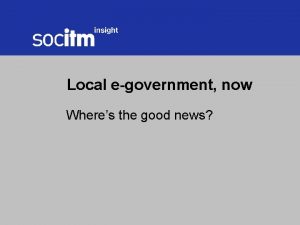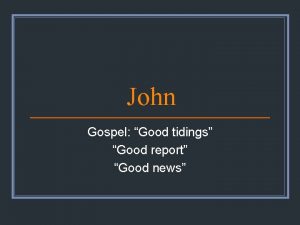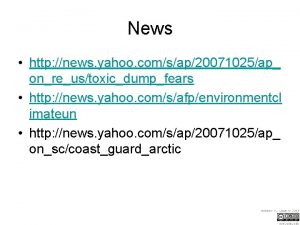Wheres the good news in cancer research Pantziarka


















- Slides: 18

Where’s the good news in cancer research? Pantziarka July 28 1993 – April 25 2011 1

Cancer Risk in LFS • LFS is associated with a germline mutation in TP 53 (around 70% of patients) • Cumulative cancer incidence 50% by age 31 years among females and 46 years among males • Nearly 100% by age 70 years for both sexes • Approximately 49% of those with a first cancer develop one or more cancers after a median of 10 years • Risk management strategies revolve around active surveillance protocols and risk reducing mastectomy 2

TAILORx – Breast Cancer • TAILORx (Trial Assigning Individualized Options for Treatment) is a very large international breast cancer trial • The trial enrolled 10, 273 women at 1, 182 sites in the United States, Australia, Canada, Ireland, New Zealand, and Peru • The aim was specifically to assess the best treatment for women with early stage hormone responsive breast cancer (ER/PR+, HER 2 , axillary lymph node negative) • The trial used the Oncotype DX Breast Recurrence Score to assess risk – with a score below 10 as low risk, 11 – 25 as intermediate and 26 and over as high risk 3

TAILORx - Results • Women in the low risk group were treated with hormone therapy, the high risk group received chemo and hormone therapy • The trial randomly assigned women in the intermediate risk group to either hormone therapy alone OR hormone therapy with chemo – reflecting current practice where there is no clear evidence on what’s best • The results clearly show chemotherapy can be avoided for the majority of women in the intermediate group • This means around 70% of women with early stage breast cancer can avoid chemotherapy 4

TAILORx and LFS Why is this relevant to women with LFS? Masciari et al. Breast cancer phenotype in women with TP 53 germline mutations: a Li Fraumeni syndrome consortium effort. Breast Cancer Res Treat 2012 Avoiding chemotherapy, like avoiding radiotherapy, can decrease the risk of subsequent cancers for women with LFS – this isn’t just about avoiding the horrible side effects of chemo, it could have longer term positive effects 5

Childhood Rhabdomyosarcoma • Rhabdomyosarcoma (RMS) is one of the ‘signature’ childhood LFS cancers • The most common soft tissue sarcoma in children – more than half diagnosed before the age of 10 • Treatment has not changed in almost 30 years: Surgery, Chemotherapy, Radiotherapy • Around 20 – 30% of children relapse after treatment –their outlook is grim and has not improved in 30 years 6

A step forward – at last! • The RMS 2005 is an international (14 countries) randomised trial in children with RMS, it took 11 years to complete! • It recruited 371 children with high risk RMS, with half receiving the standard treatment, and the other half receive standard treatment followed by six months of ‘maintenance therapy’ • The maintenance therapy was low dose (non toxic) chemotherapy (daily tablets and weekly outpatient chemotherapy) 7

RMS 2005 - Results Disease free survival at five years (i. e. five years without recurrence after treatment has ended) was 68. 8% in the standard therapy group, and 77. 6% in the maintenance therapy group Overall survival was 73. 7% in the standard therapy group and 86. 5% in the maintenance therapy group. This is the first advance in more than 30 years – and is the new standard of care in the UK and other European countries 8

Angiosarcoma • A rare soft tissue sarcoma – not one of the ‘signature’ LFS sarcomas • More common in LFS as a secondary primary caused by radiotherapy for breast cancer • Treatment has not changed in decades – chemo, surgery, radiotherapy • Could an old non-cancer drug called propranolol improve outcomes? First line anthracyclines: Young et al. Eur J Cancer. 2014 Response rate around 25%. Median PFS 4. 9 months. Median OS 9. 9 months. 9

The hemangioma story… Incidental observation in a child treated with propranolol shows rapid and sustained effects on infantile hemangioma – results repeated in 10 other children. Results confirmed in numerous patients and trials Léauté Labrèze et al. 2015. A randomized, controlled trial of oral propranolol in infantile hemangioma. The New England journal of Drug reformulated for infants medicine 372: 735– 46. Léauté Labrèze et al. 2008. The New England Journal of Medicine 358: 2649– 51. Hemangeol – FDA Approved March 2014 Hemangiol – EMA Approved Feb 2014 Successfully repurposed 10

But what about angiosarcoma? Investigators look at expression of beta receptors in range of benign and malignant tumours Brad Bryan and co workers at Texas Tech University test propranolol in animal models of angiosarcoma Stiles JM et al. 2013. Targeting of Beta Adrenergic Receptors Results in Therapeutic Efficacy against Models of Hemangioendothelioma and Angiosarcoma. Plo. S one 8: e 60021. Chisholm KM et al. 2012. β Adrenergic receptor expression in vascular tumors. Modern pathology 25: 1446– 51. 11

Propranolol and Angiosarcoma? 69 year old woman with a relapsing metastatic angiosarcoma treated with a combination of metronomic chemotherapy and propranolol. A complete response was quickly obtained and lasted for 20 months. Banavali S et al. 2015. Targeted therapy with propranolol and metronomic chemotherapy combination. Ecancermedicalscience 9: 499. Chow W et al. 2015. Growth Attenuation of Cutaneous Angiosarcoma With Propranolol Mediated β Blockade. JAMA dermatology: 1– 4. 12

More human data Pasquier E et al. 2016. Effective Management of Advanced Angiosarcoma by the Synergistic Combination of Propranolol and Vinblastine based Metronomic Chemotherapy: A Bench to Bedside Study. EBio. Medicine 6: 87– 95. Seven additional patients treated in India. 100% response rate. PFS and OS superior to standard treatments In vitro and in vivo evidence in addition to patient data Daguzé J et al. 2016. Visceral metastatic angiosarcoma treated effectively with oral cyclophosphamide combined with propranolol. JAAD case reports 2: 497– 499. To date we have more than 10 published cases – and know of other unpublished cases with good responses. 13

Next steps… Clinical trial initiated in France (PROPAN trial) Anticancer Fund gains orphan drug designation from EMA Propranolol as standard treatment option for angiosarcoma Propranolol in Angiosarcoma Task Force created Label extension Scientific Advice meeting with MHRA Additional clinical trial(s) 14

Osteosarcoma - Roadblocked Status N % Local recurrence 67 6% Metastases 497 47% No recurrence 503 47% Total 1067 100% No significant improvement in > 30 years 15

PRESTO Currently there are NO trials in localised osteosarcoma with a survival end point in Europe and North America. Only a series of independent early phase trials looking at other end points…. PRESTO: Platform for the Rapid Evaluation of Several Treatments in Osteosarcoma 16

Next steps… • Idea for PRESTO being presented at major cancer conferences… • Meetings and discussions on going with clinicians across Europe and North America… • Researching for possible drugs to test… 17

A UK LFS Registry? • A central registry of people with LFS would be extremely valuable – We can have an idea about total numbers diagnosed – A data source for further study – Easy to contact people for clinical trials or more research • To date initiatives to create a register have stalled • The national screening program will record data for people eligible for screening • This opens the door to create a centralised LFS registry for the UK as a whole • Given the possible increase in the numbers of people with LFS – based on the results from Dundee – this may become even more important 18
 No news _____ good news.
No news _____ good news. Where is scootland
Where is scootland Where is thera
Where is thera Wheres greece
Wheres greece Wheres manchuria
Wheres manchuria Wheres washington state
Wheres washington state Where's my dozer
Where's my dozer Wheres ip
Wheres ip Wheres the ip
Wheres the ip Rob is your pen friend
Rob is your pen friend Wheres the yellow river
Wheres the yellow river Wheres the ozone layer
Wheres the ozone layer Wheres fetty wap
Wheres fetty wap Wheres hadrians wall
Wheres hadrians wall Wheres my mobey
Wheres my mobey Zoroastrian good thoughts
Zoroastrian good thoughts Hello, good evening
Hello, good evening Good afternoon animado
Good afternoon animado If you are
If you are






